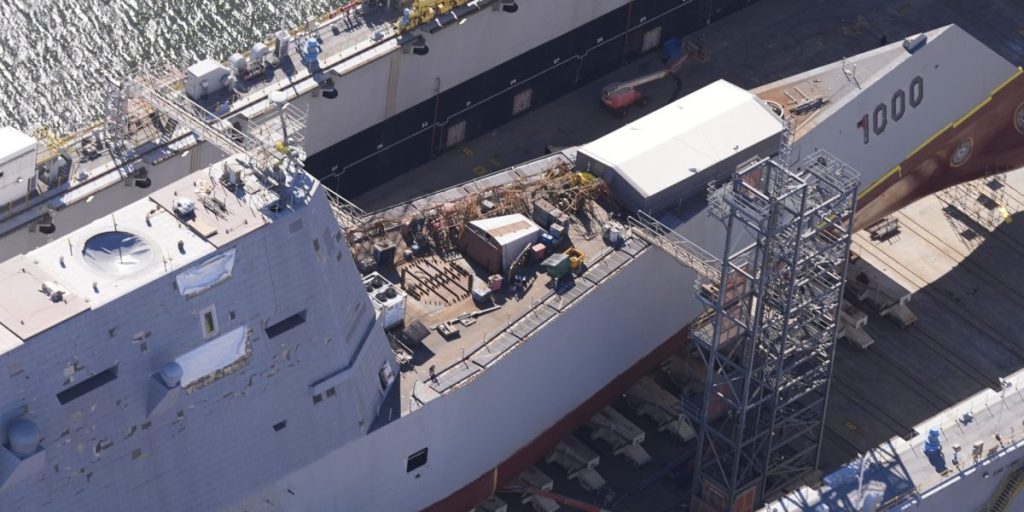The U.S. Navy is transforming a costly flub into a potent weapon with the first shipborne hypersonic weapon, which is being retrofitted aboard the first of its three stealthy destroyers.
The USS Zumwalt is at a Mississippi shipyard where workers have installed missile tubes that replace twin turrets from a gun system that was never activated because it was too expensive. Once the system is complete, the Zumwalt will provide a platform for conducting fast, precision strikes from greater distances, adding to the usefulness of the warship.
“It was a costly blunder but the Navy could take victory from the jaws of defeat here, and get some utility out of them by making them into a hypersonic platform,” said Bryan Clark, a defense analyst at the Hudson Institute.
The U.S. has had several types of hypersonic weapons in development for the past two decades, but recent tests by both Russia and China have added pressure to the U.S. military to hasten their production.
Hypersonic weapons travel beyond Mach 5, five times the speed of sound, with added maneuverability making them harder to shoot down.
Last year, The Washington Post reported that among the documents leaked by former Massachusetts Air National Guard member Jack Teixeira was a defense department briefing that confirmed China had recently tested an intermediate-range hypersonic weapon called the DF-27. While the Pentagon had previously acknowledged the weapon’s development, it had not recognized its testing.
One of the U.S. programs in development and planned for the Zumwalt is “Conventional Prompt Strike.” It would launch like a ballistic missile and then release a hypersonic glide vehicle that would travel at speeds seven to eight times faster than the speed of sound before hitting the target. The weapon system is being developed jointly by the Navy and Army. Each of the Zumwalt-class destroyers would be equipped with four missile tubes, each with three of the missiles for a total of 12 hypersonic weapons per ship.
In choosing the Zumwalt, the Navy is attempting to add to the usefulness of a $7.5 billion warship that is considered by critics to be an expensive mistake despite serving as a test platform for multiple innovations.
The Zumwalt was envisioned as providing land-attack capability with an Advanced Gun System with rocket-assisted projectiles to open the way for Marines to charge ashore. But the system featuring 155 mm guns hidden in stealthy turrets was canceled because each of the rocket-assisted projectiles cost between $800,000 and $1 million.
Despite the stain on its reputation, the three Zumwalt-class destroyers remain the Navy’s most advanced surface warship in terms of new technologies. Those innovations include electric propulsion, an angular shape to minimize radar signature, an unconventional wave-piercing hull, automated fire and damage control and a composite deckhouse that hides radar and other sensors.
The Zumwalt arrived at the Huntington Ingalls Industries shipyard in Pascagoula, Mississippi, in August 2023 and was removed from the water for the complex work of integrating the new weapon system. It is due to be undocked this week in preparation for the next round of tests and its return to the fleet, shipyard spokeswoman Kimberly Aguillard said.
A U.S. hypersonic weapon was successfully tested over the summer and development of the missiles is continuing. The Navy wants to begin testing the system aboard the Zumwalt in 2027 or 2028, according to the Navy.
The U.S. weapon system will come at a steep price. It would cost nearly $18 billion to buy 300 of the weapons and maintain them over 20 years, according to the Congressional Budget Office.
Critics say there is too little bang for the buck.
“This particular missile costs more than a dozen tanks. All it gets you is a precise non-nuclear explosion, some place far far away. Is it really worth the money? The answer is most of the time the missile costs much more than any target you can destroy with it,” said Loren Thompson, a longtime military analyst in Washington, D.C.
But they provide the capability for Navy vessels to strike an enemy from a distance of thousands of kilometers — outside the range of most enemy weapons — and there is no effective defense against them, said retired Navy Rear Adm. Ray Spicer, CEO of the U.S. Naval Institute, a think tank, and former commander of an aircraft carrier strike force.
Conventional missiles that cost less aren’t much of a bargain if they are unable to reach their targets, Spicer said, adding the U.S. military really has no choice but to pursue them.
“The adversary has them. We never want to be outdone,” he said.
The U.S. is accelerating development because hypersonics have been identified as vital to U.S. national security with “survivable and lethal capabilities,” said James Weber, principal director for hypersonics in the Office of the Assistant Secretary of Defense for Critical Technologies.
“Fielding new capabilities that are based on hypersonic technologies is a priority for the defense department to sustain and strengthen our integrated deterrence, and to build enduring advantages,” he said.
How many degrees of separation are you from the globe’s most powerful business leaders? Explore who made our brand-new list of the 100 Most Powerful People in Business. Plus, learn about the metrics we used to make it.
